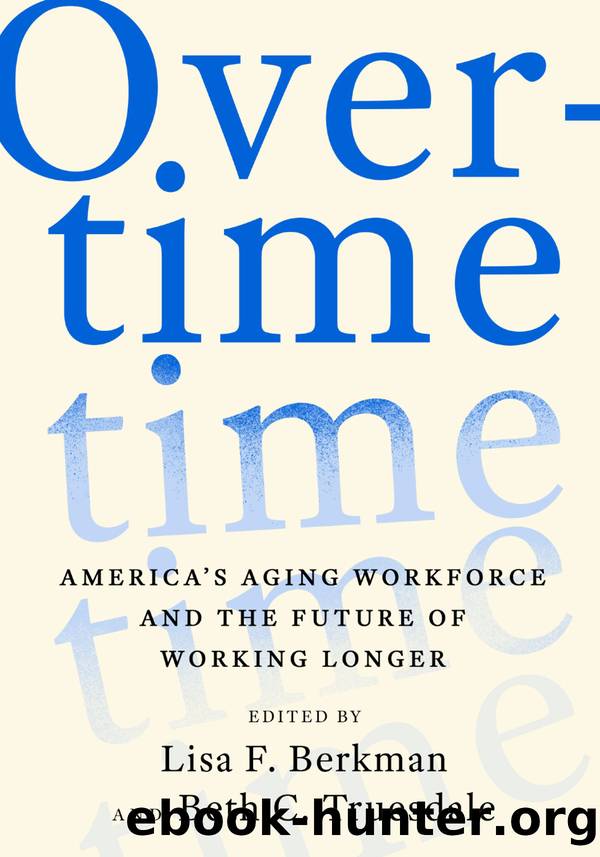Overtime by Berkman Lisa F.;Truesdale Beth C.;

Author:Berkman, Lisa F.;Truesdale, Beth C.;
Language: eng
Format: epub
Publisher: Oxford University Press, Incorporated
Published: 2022-06-15T00:00:00+00:00
Notes
1.We will use the terms âworkingâ and âemployedâ interchangeably. Both terms include the self-employed.
2.The RAND HRS Longitudinal File is an easy-to-use dataset based on the HRS core data. This file was developed at RAND with funding from the National Institute on Aging and the Social Security Administration.
3.P70 was added to HRS in 2012 so the follow-up is not yet long enough to compare expectations to subsequent actual work status for P70.
4.Because the HRS did not ask about any work after age 62, we use P62, the subjective probability of full-time work to anchor at age 62.
5.The fraction of the older population with a college degree increased substantially between 1992 and 2016, which may have contributed to this change. However, when we classified by education quartiles, rather than by degree of education, the decline remained large: 11 percentage points.
References
Banerjee, Sudipto, and David Blau. 2016. âEmployment Trends by Age in the United States Why Are Older Workers Different?â Journal of Human Resources 51 (1): 163â199. https://doi.org/10.3368/jhr.51.1.163.
Blundell, Richard, Jack Britton, Monica Costa Dias, and Eric French. 2017. âThe Impact of Health on Labour Supply Near Retirement.â Working Paper W17/18. London: Institute for Fiscal Studies. https://doi.org/10.1920/wp.ifs.2017.W1718.
Bosworth, Barry, Gary Burtless, and Kan Zhang. 2016. Later Retirement, Inequality in Old Age, and the Growing Gap in Longevity between Rich and Poor. Economic Studies at Brookings. Washington, DC: The Brookings Institution. https://www.brookings.edu/wp-content/uploads/2016/02/BosworthBurtlessZhang_retirementinequalitylongevity.pdf.
Chernew, Michael, David M. Cutler, Kaushik Ghosh, and Mary Beth Landrum. 2017. âUnderstanding the Improvement in Disability-Free Life Expectancy in the U.S. Elderly Population.â In Insights in the Economics of Aging, edited by David A. Wise, 161â204. University of Chicago Press. http://www.nber.org/chapters/c13631. Accessed June 02, 2022.
Coile, Courtney C. 2003. âRetirement Incentives and Couplesâ Retirement Decisions.â Working Paper 9496. Working Paper Series. National Bureau of Economic Research. https://doi.org/10.3386/w9496.
Coile, Courtney C. 2015. âEconomic Determinants of Workersâ Retirement Decisions.â Journal of Economic Surveys 29 (4): 830â853. https://doi.org/10.1111/joes.12115. Accessed June 02, 2022.
Coile, Courtney C., and Phillip B. Levine. 2010. Reconsidering Retirement: How Losses and Layoffs Affect Older Workers. Washington, DC: Brookings Institution Press. http://muse.jhu.edu/book/356.
Hurd, Michael D. 1990. âThe Joint Retirement Decision of Husbands and Wives.â In Issues in the Economics of Aging, edited by David A. Wise, 231â254. A National Bureau of Economic Research Project Report. Chicago: University of Chicago Press.
Hurd, Michael D. 2009. âSubjective Probabilities in Household Surveys.â Annual Review of Economics 1 (1): 543â562. https://doi.org/10.1146/annurev.economics.050708.142955.
Hurd, Michael D., and Susann Rohwedder. 2011. âTrends in Labor Force Participation: How Much Is Due to Changes in Pensions?â Journal of Population Ageing 4 (1â2): 81â96. https://doi.org/10.1007/s12062-011-9042-8.
McGarry, Kathleen. 2004. âHealth and Retirement: Do Changes in Health Affect Retirement Expectations?â The Journal of Human Resources 39 (3): 624â648. https://doi.org/10.2307/3558990.
RAND HRS Longitudinal File 2016 (V1). Produced by the RAND Center for the Study of Aging, with funding from the National Institute on Aging and the Social Security Administration. Santa Monica, CA.
Sasson, Isaac. 2016. âTrends in Life Expectancy and Lifespan Variation by Educational Attainment: United States, 1990â2010.â Demography 53 (2): 269â293. https://doi.org/10.1007/s13524-015-0453-7.
Schaeffer, Katherine. 2020. â6 Facts about Economic Inequality in the U.S.â Pew Research Center. February 7, 2020.
Download
This site does not store any files on its server. We only index and link to content provided by other sites. Please contact the content providers to delete copyright contents if any and email us, we'll remove relevant links or contents immediately.
Cecilia; Or, Memoirs of an Heiress — Volume 1 by Fanny Burney(32438)
Cecilia; Or, Memoirs of an Heiress — Volume 2 by Fanny Burney(31875)
Cecilia; Or, Memoirs of an Heiress — Volume 3 by Fanny Burney(31858)
The Great Music City by Andrea Baker(31524)
We're Going to Need More Wine by Gabrielle Union(18972)
All the Missing Girls by Megan Miranda(15592)
Pimp by Iceberg Slim(14398)
Bombshells: Glamour Girls of a Lifetime by Sullivan Steve(13978)
Talking to Strangers by Malcolm Gladwell(13232)
Norse Mythology by Gaiman Neil(13212)
Fifty Shades Freed by E L James(13162)
For the Love of Europe by Rick Steves(13101)
Mindhunter: Inside the FBI's Elite Serial Crime Unit by John E. Douglas & Mark Olshaker(9206)
Crazy Rich Asians by Kevin Kwan(9171)
The Lost Art of Listening by Michael P. Nichols(7411)
Enlightenment Now: The Case for Reason, Science, Humanism, and Progress by Steven Pinker(7240)
The Four Agreements by Don Miguel Ruiz(6637)
Bad Blood by John Carreyrou(6558)
Weapons of Math Destruction by Cathy O'Neil(6151)
